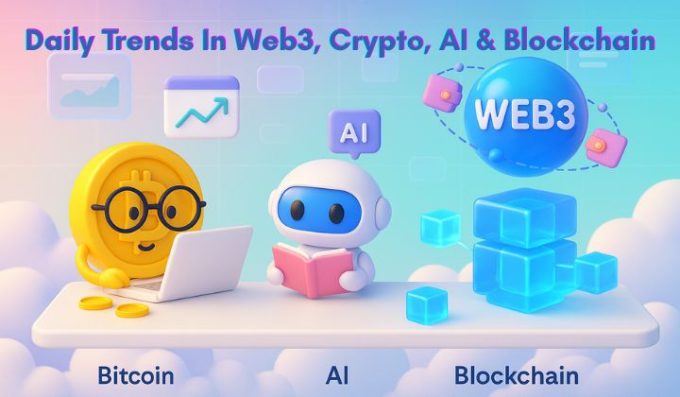Web3 Social Media Platforms: The Future of Social Media?
By Sandeep Kasalkar
Web3 social media refers to a new generation of social media platforms that are built on the principles of Web3 technology and philosophy. Web3 represents the evolution of the internet from its current state (Web2) into a decentralized, user-centric, and privacy-focused ecosystem.
In the context of social media, Web3 platforms aim to address many of the limitations and concerns associated with traditional, centralized social media platforms.
Social computing refers to the social and interactive aspects of internet activities. In contrast to personal computing, which refers to the actions of a single user, the phrase might be understood differently.
Social computing is exemplified through blogs, wikis, Twitter, RSS, instant messaging, multi-gaming, and open source development. Social networking and social bookmarking sites are also included. Web 2.0 may be defined as the architecture for apps that support its processes.
The phrase “social computing” is a bit misleading. Social computer applications should not be confused with artificial intelligence programmes such as socially intelligent computing. The computer must demonstrate social talents and make the person using it feel more socially involved even when they are not.
Understanding Web3: A Brief Overview
What is Web3?
Web3 represents the next phase of the internet’s evolution. It encompasses a decentralized web architecture that prioritizes user ownership, data privacy, and peer-to-peer interactions. Unlike the traditional Web2 model, where centralized platforms control user data, Web3 empowers users with greater control over their personal information and digital presence.
Key Technologies Underpinning Web3:
1-Blockchain Technology: At the heart of Web3 lies blockchain, a distributed and immutable ledger that ensures transparency, security, and trust in transactions and interactions.
2-Smart Contracts: These self-executing contracts automate and facilitate processes, enabling secure and transparent peer-to-peer transactions without intermediaries.
3-Decentralized Identity (DID): DID solutions allow users to have self-sovereign control over their digital identity, enhancing privacy and reducing reliance on centralized identity providers.
Web3 Social Media Platforms: A Paradigm Shift
Decentralized Content Sharing:
Traditional social media platforms often exercise control over the visibility and reach of users’ content. Web3 social media platforms, on the other hand, provide users with direct control over their content. Content creators can distribute their creations without the fear of censorship or algorithmic bias.
Tokenized Economies:
Many Web3 social media platforms leverage cryptocurrency tokens to incentivize and reward users for their contributions. These tokens can be earned by sharing content, engaging with others, or even curating valuable content. This introduces a new dimension of economic interaction within the social media space.
Enhanced Data Privacy:
Web2 social media platforms have faced criticism for mishandling user data. Web3 social media platforms prioritize data privacy by giving users ownership of their data. Users can choose what information to share and retain control over how it’s utilized.
Censorship Resistance:
Centralized social media platforms have been criticized for arbitrary content takedowns and censorship. Web3 social media platforms aim to eliminate this issue by relying on decentralized architectures, making it harder for any single entity to control the platform’s content.
Prominent Web3 Social Media Platforms
Steemit: Rewarding Content Creation
Steemit introduced the concept of rewarding content creators and curators with its cryptocurrency token, STEEM. Users are incentivized to produce valuable content, as their earnings are tied to community engagement and appreciation.
Mastodon: A Decentralized Twitter Alternative
Mastodon offers a decentralized and federated microblogging platform. Instead of a single central server, it consists of multiple independently operated servers, fostering diverse communities.
Peepeth: A Minimalistic Approach
Peepeth combines the microblogging format with blockchain technology to create a censorship-resistant platform where every interaction is recorded on the Ethereum blockchain.
Challenges and Future Prospects:
Usability and Accessibility-
Web3 technologies are still relatively complex for the average user. Enhancing user experience and making these platforms more accessible will be crucial for their mainstream adoption.
Scalability-
Many blockchain-based platforms struggle with scalability issues, hindering their ability to accommodate a large user base and high transaction volumes.
Regulatory Concerns-
The decentralized nature of Web3 platforms presents challenges in terms of legal and regulatory frameworks. Striking a balance between innovation and compliance will be pivotal.
Social computing types:
Social science-oriented
Computational social science is a branch of social science that focuses on the use of computer technology to the study of society. This research topic includes social network analysis and computational social science.
First, social network analysis focuses on social fluidity, healthcare, disease transmission key node mining, and community detection. There are three types of social network analysis approaches: agent-based modelling, theoretical physics methods, and graph theory.
Application-oriented
Application-oriented social computing is a form of application that makes use of the ideas and technology of social computing, such as communities, social networks, and sociology. Group software, social software, and social media were the three stages of the application-oriented social computing era.
Users can develop, consume, and engage with one another via social networking sites, which promotes user participation. The widespread usage of ubiquitous gadgets such as mobile phones and smart devices has piqued the interest of academia and industry.
The significance of social computing in business
- Increased innovation
- Enhanced productivity
- Employee interactions and engagement have improved.
- Recruiting and keeping younger workers
- Public relations and promotion
Businesses may use social computing to connect with their customers and promote their brands. Since it allows a company to respond promptly to client problems by monitoring public opinion about its brand, social computing may improve customer relationship management (CRM). Many large corporations have also begun to use crowdsourcing for research. Enterprise 2.0 is the phrase used by organisations to characterise the adoption of social computing applications.
Conclusion:
Web3 social media platforms are poised to revolutionize the way we interact online. By prioritizing user ownership, data privacy, and censorship resistance, they offer a promising alternative to the centralized Web2 model. While challenges remain, the potential benefits these platforms bring to digital interaction and expression are undeniable. As Web3 continues to evolve, we stand on the brink of a new era of decentralized social media.
You need to login in order to Like














